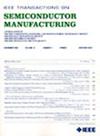Characterization of Multimodal Spot Scanning Imaging System for Wafer Defect Inspection
IF 2.3
3区 工程技术
Q2 ENGINEERING, ELECTRICAL & ELECTRONIC
引用次数: 0
Abstract
Typical defects on unpatterned wafers include particles, residues, scratches, and cracks. Various dark-field scattering methods have been applied to detect unpatterned wafer surface defects. However, these methods have only one optical detection channel, making handling multiple types of wafer defects difficult. In response, the theory of multimodal defect inspection is improved, and a multimodal spot-scanning imaging system is developed. The laser beam is focused on the wafer surface, generating micron-level high-intensity focused spot illumination. Scattered light from the wafer surface is collected by the dark-field objective, and the intensity is measured by the photodiode. Reflected light from the wafer surface is collected by the bright-field objective. After polarization splitting, it is measured by two four-quadrant detectors to analyze the topography, film, and reflected signal. The turntable and linear guide drive the optical head and wafer, allowing the focused spot to scan along the wafer in a spiral trajectory, enabling fast and accurate detection. The defect inspection system has been verified through experiments. The minimum detectable PSL particle size is less than 200 nm, the minimum detectable scratch width is less than用于晶圆缺陷检测的多模态点扫描成像系统的特性研究
非图案化晶圆上的典型缺陷包括颗粒、残留物、划痕和裂纹。各种暗场散射方法已被应用于检测非图像化晶圆表面缺陷。然而,这些方法只有一个光学检测通道,使得处理多种类型的晶圆缺陷变得困难。为此,改进了多模态缺陷检测理论,开发了多模态点扫描成像系统。激光束聚焦在晶圆表面,产生微米级高强度聚焦光斑照明。来自晶圆表面的散射光由暗场物镜收集,并由光电二极管测量其强度。来自晶圆表面的反射光被明场物镜收集。偏振分裂后,用两个四象限探测器测量,分析形貌、薄膜和反射信号。转台和线性导轨驱动光学头和晶圆,使聚焦点沿晶圆沿螺旋轨迹扫描,实现快速准确的检测。该缺陷检测系统已通过实验验证。最小可检测PSL粒径小于200 nm,最小可检测划痕宽度小于$1~\mu $ m,最小可检测染色宽度小于$20~\mu $ m。
本文章由计算机程序翻译,如有差异,请以英文原文为准。
求助全文
约1分钟内获得全文
求助全文
来源期刊

IEEE Transactions on Semiconductor Manufacturing
工程技术-工程:电子与电气
CiteScore
5.20
自引率
11.10%
发文量
101
审稿时长
3.3 months
期刊介绍:
The IEEE Transactions on Semiconductor Manufacturing addresses the challenging problems of manufacturing complex microelectronic components, especially very large scale integrated circuits (VLSI). Manufacturing these products requires precision micropatterning, precise control of materials properties, ultraclean work environments, and complex interactions of chemical, physical, electrical and mechanical processes.
 求助内容:
求助内容: 应助结果提醒方式:
应助结果提醒方式:


